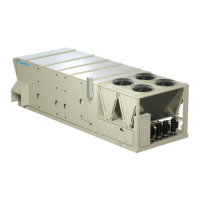Do you have a question about the Daikin DZ16 and is the answer not in the manual?
Guidelines for safely handling refrigerants, including precautions for pressure, temperature, and personal protection.
Identify and understand safety symbols, words, and labels used in the manual and on the equipment for safe operation.
Explains product identification coding for air handler models, including unit application and features.
Details product identification coding for various condenser models, covering type, SEER, and tonnage.
Provides product identification and revision details for DX13SA condenser units.
Describes the refrigerant cycle and operation during cooling mode.
Explains the defrost cycle control and operation for legacy models.
Explains the refrigerant cycle reversal for heating operation.
Describes the system operation during heating mode.
Details the step-by-step process of the cooling cycle.
Procedure for checking system voltage and locked rotor voltage.
Checks the loss of charge protector for proper function.
Table detailing CoreSense module flash codes and troubleshooting.
A quick reference table for alert codes and conditions.
Procedure for checking run capacitors for proper function.
Checks capacitor value using a multi-meter's capacitance function.
Checks for ground faults in the compressor circuit.
Tests system operation after component checks.
Tests the reversing valve and solenoid for proper operation.
Procedure for leak testing using nitrogen or nitrogen-traced gas.
Procedure for charging the system with refrigerant.
Troubleshooting and identifying refrigerant overfeeding.
Explains how to check and adjust subcooling.
Troubleshoots a restricted liquid line and its effects.
Steps for visually inspecting and testing wiring for continuity.
Procedure for testing contactor and relay coils for continuity.
Tests the high pressure control for proper cut-out setting.
Tests fan and blower motor windings for continuity.
Provides safety warnings and guidelines for checking the compressor.
Procedure for testing the compressor unloader solenoid.
Verifies proper rotation of 3-phase scroll compressors.
Tests the defrost control sequencing.
Steps for properly evacuating the system to remove air and moisture.
Describes the operation of thermostatic expansion valves.
Troubleshooting and identifying refrigerant underfeeding.
Identifies symptoms and checks for refrigerant overcharge.
Checks thermostat and wiring for proper cooling/heating signals.
Tests the continuity of contactor contacts under load.
Tests the low pressure control for proper cut-out setting.
Tests capacitor resistance using a digital multi-meter.
Checks high efficiency (EEM) motors for proper operation.
Tests compressor motor windings resistance.
Tests the defrost thermostat for proper temperature settings.
General practices for repairing refrigeration systems safely.
Explains how to check and adjust superheat.
Tests the expansion valve for proper operation.
Diagnoses and addresses non-condensables in the system.
Adjusting superheat and subcooling for TXV systems.
Diagnoses compressor burnout and related issues.
Guidelines for safely handling refrigerants, including precautions for pressure, temperature, and personal protection.
Identify and understand safety symbols, words, and labels used in the manual and on the equipment for safe operation.
Explains product identification coding for air handler models, including unit application and features.
Details product identification coding for various condenser models, covering type, SEER, and tonnage.
Provides product identification and revision details for DX13SA condenser units.
Describes the refrigerant cycle and operation during cooling mode.
Explains the defrost cycle control and operation for legacy models.
Explains the refrigerant cycle reversal for heating operation.
Describes the system operation during heating mode.
Details the step-by-step process of the cooling cycle.
Procedure for checking system voltage and locked rotor voltage.
Checks the loss of charge protector for proper function.
Table detailing CoreSense module flash codes and troubleshooting.
A quick reference table for alert codes and conditions.
Procedure for checking run capacitors for proper function.
Checks capacitor value using a multi-meter's capacitance function.
Checks for ground faults in the compressor circuit.
Tests system operation after component checks.
Tests the reversing valve and solenoid for proper operation.
Procedure for leak testing using nitrogen or nitrogen-traced gas.
Procedure for charging the system with refrigerant.
Troubleshooting and identifying refrigerant overfeeding.
Explains how to check and adjust subcooling.
Troubleshoots a restricted liquid line and its effects.
Steps for visually inspecting and testing wiring for continuity.
Procedure for testing contactor and relay coils for continuity.
Tests the high pressure control for proper cut-out setting.
Tests fan and blower motor windings for continuity.
Provides safety warnings and guidelines for checking the compressor.
Procedure for testing the compressor unloader solenoid.
Verifies proper rotation of 3-phase scroll compressors.
Tests the defrost control sequencing.
Steps for properly evacuating the system to remove air and moisture.
Describes the operation of thermostatic expansion valves.
Troubleshooting and identifying refrigerant underfeeding.
Identifies symptoms and checks for refrigerant overcharge.
Checks thermostat and wiring for proper cooling/heating signals.
Tests the continuity of contactor contacts under load.
Tests the low pressure control for proper cut-out setting.
Tests capacitor resistance using a digital multi-meter.
Checks high efficiency (EEM) motors for proper operation.
Tests compressor motor windings resistance.
Tests the defrost thermostat for proper temperature settings.
General practices for repairing refrigeration systems safely.
Explains how to check and adjust superheat.
Tests the expansion valve for proper operation.
Diagnoses and addresses non-condensables in the system.
Adjusting superheat and subcooling for TXV systems.
Diagnoses compressor burnout and related issues.
| Refrigerant | R-410A |
|---|---|
| Voltage | 208/230V |
| Cooling Capacity (BTU/h) | 18, 000 - 60, 000 |
| Dimensions (Indoor Unit) | Varies by model |
| Dimensions (Outdoor Unit) | Varies by model |
| Weight (Indoor Unit) | Varies by model |
| Weight (Outdoor Unit) | Varies by model |
| Type | Air Conditioner |
| Cooling Capacity | 1.5 - 5 Tons |
| Energy Efficiency | High |
| Phase | Single |
| Indoor Unit Noise Level | 19-45 dB |
| Outdoor Unit Noise Level | 54-75 dB |












